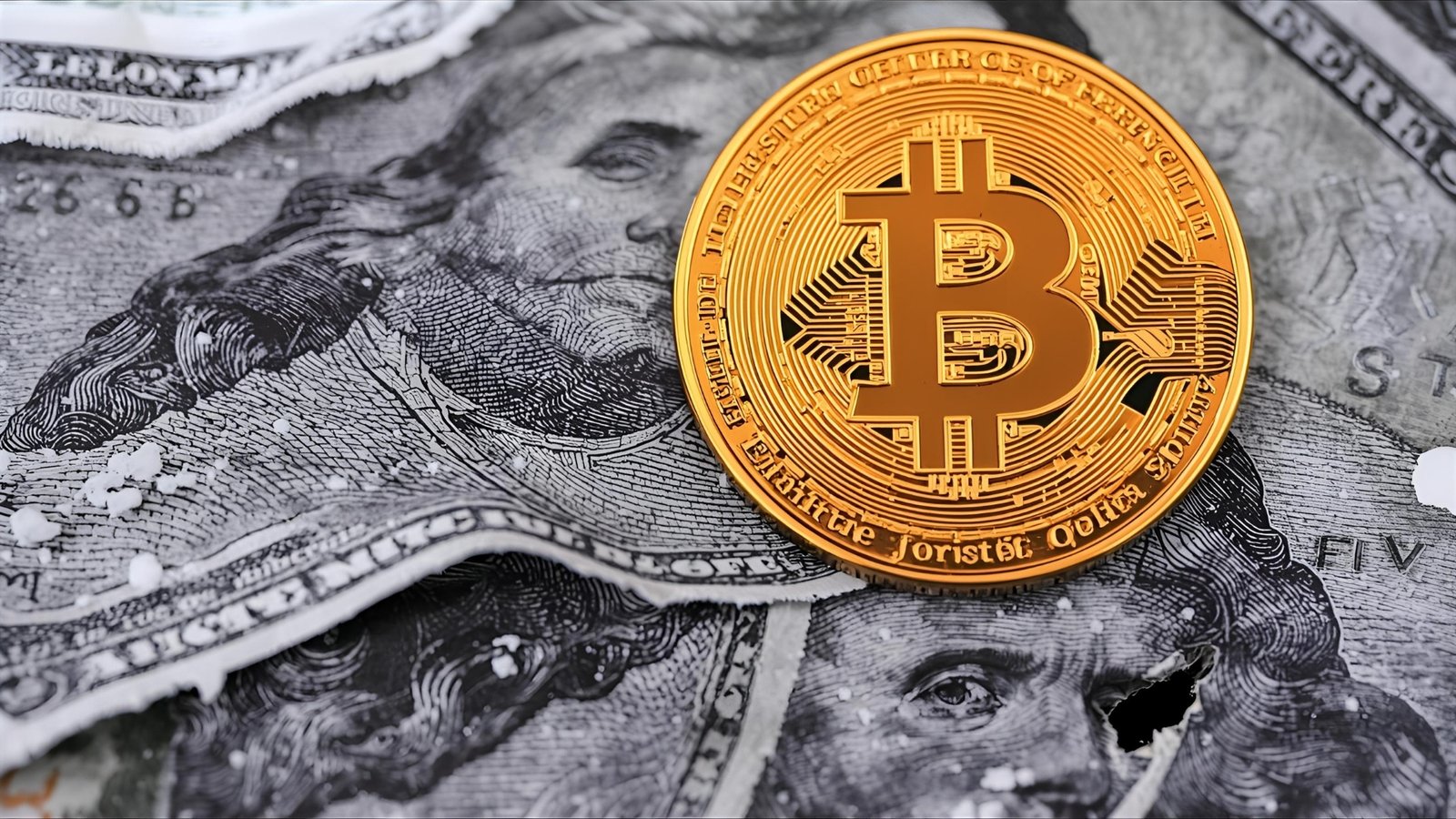The cryptocurrency market has been in a state of flux as Bitcoin (BTC) recently experienced a significant price drop, Bitcoin Price Crash Below $108K. This decline has left many traders on edge as they anticipate the upcoming Federal Reserve (Fed) rate cut decision. Bitcoin, along with other cryptocurrencies, is highly sensitive to changes in global financial conditions, including interest rates.
This article delves into the factors behind Bitcoin’s price crash, the relationship between Federal Reserve policies and cryptocurrency markets, and what traders can expect moving forward. We’ll explore how inflation data, market sentiment, and investor behavior play pivotal roles in shaping Bitcoin’s volatile price movements. By understanding these dynamics, traders can better navigate the challenges and opportunities that lie ahead.
What Caused Bitcoin’s Price Crash?

Market Reactions to Fed Policy Announcements
The Federal Reserve’s monetary policy decisions have a significant impact on global financial markets, including cryptocurrencies. In particular, the anticipation of a rate cut has often triggered speculative activity. Rate cuts typically signal that the Fed is aiming to stimulate the economy by making borrowing cheaper, which can lead to increased liquidity in financial markets.
However, the initial optimism surrounding a potential rate cut may quickly shift if investors feel that such a move could be an indication of deeper economic problems. In Bitcoin’s case, the price drop below $108K occurred amid growing concerns about the overall health of the global economy, especially with inflationary pressures continuing to persist. Traders have become cautious, awaiting the Fed’s next move, unsure of whether a rate cut will be the signal for more economic instability or a sign of recovery.
Inflation Concerns and Bitcoin’s Role as a Hedge
Bitcoin is often touted as a hedge against inflation, with its limited supply and decentralized nature positioning it as an alternative to traditional fiat currencies. When inflation rises, the purchasing power of fiat currencies erodes, and assets like gold and Bitcoin are considered safe havens. However, in recent months, Bitcoin has struggled to maintain its reputation as a hedge against inflation. The global inflationary environment, paired with rising interest rates, has created a challenging landscape for Bitcoin and other cryptocurrencies.
As inflation remains high, the demand for safe assets, including Bitcoin, has fluctuated. Bitcoin’s price dropping below $108K could be seen as a reflection of investors’ shifting sentiment, where they are more risk-averse as they await clearer economic signals from the Fed. Some traders have opted for more traditional safe-haven assets like gold, while others have taken a wait-and-see approach with Bitcoin.
The Role of the Federal Reserve in Bitcoin’s Price Dynamics
The Connection Between Interest Rates and Cryptocurrency Prices
Bitcoin’s price is influenced by numerous factors, but one of the most impactful is the Federal Reserve’s interest rate decisions. Higher interest rates generally lead to a stronger dollar, which reduces demand for riskier assets like Bitcoin. Conversely, lower rates tend to weaken the dollar and encourage investment in alternative assets like cryptocurrencies.
When the Fed raises interest rates, borrowing becomes more expensive, which often leads to reduced liquidity in financial markets. In this environment, investors may move away from riskier assets, causing a decline in Bitcoin’s price. On the other hand, rate cuts could lead to a resurgence in risk appetite, prompting a rally in cryptocurrencies. This dynamic explains why Bitcoin’s price is often highly sensitive to changes in Fed policy, making traders particularly attuned to any potential rate adjustments.
Market Sentiment Ahead of the Fed’s Rate Cut Decision
The build-up to a Fed rate decision typically generates a lot of uncertainty in the market. Investors often speculate about the potential outcomes and adjust their portfolios accordingly. As the market approaches a rate cut, there is usually a mix of optimism and caution. Optimism arises from the expectation that lower rates could stimulate the economy, leading to more investment in riskier assets like Bitcoin. On the other hand, caution stems from concerns that the Fed might not cut rates enough to stave off recessionary pressures. This uncertainty has played a key role in Bitcoin’s price decline, as traders are hesitant to make significant moves until they have more clarity on the Fed’s stance.
As a result, Bitcoin’s price has been swinging wildly, reflecting the volatile nature of the broader financial market in response to potential rate cuts. However, the initial optimism surrounding a potential rate cut may quickly shift if investors feel that such a move could be an indication of deeper economic problems. In Bitcoin’s case, the price drop below $108K occurred amid growing concerns about the overall health of the global economy, especially with inflationary pressures continuing to persist. Traders have become cautious, awaiting the Fed’s next move, unsure of whether a rate cut will be the signal for more economic instability or a sign of recovery.
How Traders Are Reacting to the Price Drop

Increased Volatility and Short-Term Trading
The recent Bitcoin price crash below $108K has sparked increased volatility in the cryptocurrency market. Many traders, particularly those focused on short-term gains, have been capitalizing on these price swings. The heightened volatility has created opportunities for day traders and swing traders to profit from Bitcoin’s rapid fluctuations.
While some traders are waiting for a more favorable buying opportunity, others are taking advantage of the downtrend by short-selling Bitcoin. Short-selling, which involves borrowing and selling Bitcoin with the expectation that its price will decline further, has become a common strategy in the current market environment. The uncertainty surrounding the Fed’s rate decision has only amplified the volatility, leading to more speculative trading.
Long-Term Investors Maintaining Positions
Despite the recent price drop, long-term investors in Bitcoin are generally holding their positions. Many of these investors believe that Bitcoin’s long-term value will eventually increase, especially as it continues to gain mainstream adoption. The volatility and short-term price movements are seen as temporary fluctuations in a larger trend toward higher adoption of Bitcoin as a store of value and means of exchange.
Long-term investors typically view market downturns as opportunities to accumulate more Bitcoin at a lower price. The price crash below $108K may present an attractive entry point for those with a long-term outlook. These investors are less concerned about the short-term effects of the Fed’s decision, focusing instead on Bitcoin’s potential as a future asset class.
What to Expect Going Forward

The Potential Impact of the Fed’s Rate Cut on Bitcoin
If the Federal Reserve announces a rate cut, Bitcoin’s price could experience a significant rebound, especially if the rate cut is seen as a signal of economic recovery. Lower interest rates generally lead to an increase in the money supply, which can drive up demand for alternative investments like Bitcoin. As liquidity returns to the market, more capital may flow into Bitcoin, helping to drive its price back above key resistance levels.
However, if the rate cut is not enough to counterbalance inflationary pressures or if the Fed signals further rate cuts in the future, Bitcoin could continue to face downward pressure. Traders will be closely monitoring any signs of economic weakness or instability that could hinder Bitcoin’s ability to gain momentum.
Global Economic Factors and Bitcoin’s Price Outlook
In addition to the Fed’s rate decision, Bitcoin’s price will also be influenced by global economic factors. Trade tensions, geopolitical instability, and ongoing concerns about inflation can all impact investor sentiment and Bitcoin’s value. While Bitcoin is often seen as a hedge against inflation, it is not immune to broader economic trends. In Bitcoin’s case, the price drop below $108K occurred amid growing concerns about the overall health of the global economy, especially with inflationary pressures continuing to persist. Traders have become cautious, awaiting the Fed’s next move, unsure of whether a rate cut will be the signal for more economic instability or a sign of recovery.
The global economic outlook, coupled with the Fed’s policies, will likely play a pivotal role in determining Bitcoin’s trajectory in the near term. Traders and investors will need to stay informed about macroeconomic developments to make more informed decisions about their Bitcoin holdings.
Conclusion
The recent Bitcoin price crash below $108K highlights the ongoing volatility in the cryptocurrency market, driven in part by the uncertainty surrounding the Federal Reserve’s upcoming rate decision. While short-term traders are capitalizing on the price fluctuations, long-term investors are holding steady, betting on Bitcoin’s future potential.
As the global economy continues to grapple with inflation and other economic challenges, Bitcoin’s role as a store of value will be tested. However, the cryptocurrency market remains resilient, and Bitcoin’s price could recover quickly if the Fed’s actions align with investor expectations.
FAQs
Q: What caused Bitcoin’s price to drop below $108K?
A: Bitcoin’s price drop is mainly due to market uncertainty surrounding the Federal Reserve’s rate cut decision, inflation concerns, and shifting investor sentiment.
Q: How do interest rates impact Bitcoin’s price?
A: Higher interest rates often strengthen the dollar and reduce demand for riskier assets like Bitcoin, while lower rates can encourage investment in cryptocurrencies.
Q: Should I buy Bitcoin during a price drop?
A: If you are a long-term investor, price drops can present buying opportunities. However, it’s important to assess the broader economic conditions before making any investment.
Q: How does Bitcoin react to rate cuts?
A: Bitcoin generally benefits from rate cuts as they can lead to increased liquidity and higher demand for alternative assets like Bitcoin.
Q: What is the future outlook for Bitcoin’s price?
A: Bitcoin’s price will depend on several factors, including the Fed’s monetary policy, global economic conditions, and continued adoption of cryptocurrencies.
Read More: Bitcoin Chart Live Real Time Guide to Reading Trends


